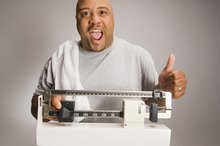How Many Calories Should I Eat If I Run 4 Miles a Day?
One of the biggest fitness myths is that you can eat anything you want as long as you exercise. Even if you keep up a solid fitness regimen and run 4 miles per day, you need to keep your calories in check if you want to prevent your weight from creeping up. How many calories you can consume daily depends on your size, body composition, age and gender. Your activity level during the rest of the day also factors into the equation.
Rough Estimates
Running 4 miles per day qualifies you as active, rather than sedentary or moderately active. Active women should eat between 2,000 and 2,400 calories per day, while active men should aim for between 2,400 and 3,000 calories. Younger people and people with an active day job should aim for the higher end of the range. Older people and those who spend much of their work day seated should aim for the lower end of the range. The larger and more muscular you are, the more calories you need, too 1.
- Running 4 miles per day qualifies you as active, rather than sedentary or moderately active.
- Older people and those who spend much of their work day seated should aim for the lower end of the range.
The Best Way to Tell
How Many Calories Should a Ten Year Old Female Eat a Day?
Learn More
Caloric recommendations aren't perfect. The best way for you to figure out how many calories you need is to monitor your weight 1. If you're running 4 miles daily and gaining weight, chances are you're eating too many calories and should aim for a lower daily target. If you are eating at the high end of the range for your age and gender, but continue to lose weight without wanting to, add 200 to 500 more calories daily to maintain your weight.
- Caloric recommendations aren't perfect.
- If you're running 4 miles daily and gaining weight, chances are you're eating too many calories and should aim for a lower daily target.
Related Articles
References
- Time: Five Things You’re Getting Wrong About Weight and Weight Loss Read more: Five Things You’re Getting Wrong About Weight and Weight Loss
- USDA Dietary Guidelines 2010: Balancing Calories
- Ndahimana D, Choi YJ, Park JH, Ju MJ, Kim EK. Validity of predictive equations for resting energy expenditure in Korean non-obese adults. Nutr Res Pract. 2018;12(4):283-290. doi:10.4162/nrp.2018.12.4.283
- United States Department of Health and Human Services. DIETARY GUIDELINES FOR AMERICANS 2015-2020 EIGHTH EDITION. 2015.
- Mcmurray RG, Soares J, Caspersen CJ, Mccurdy T. Examining variations of resting metabolic rate of adults: a public health perspective. Med Sci Sports Exerc. 2014;46(7):1352-8. doi:10.1249/MSS.0000000000000232
- Sumithran P, Proietto J. Safe year-long use of a very-low-calorie diet for the treatment of severe obesity. Med J Aust. 2008;188(6):366-8.
Writer Bio
Andrea Boldt has been in the fitness industry for more than 20 years. A personal trainer, run coach, group fitness instructor and master yoga teacher, she also holds certifications in holistic and fitness nutrition.









